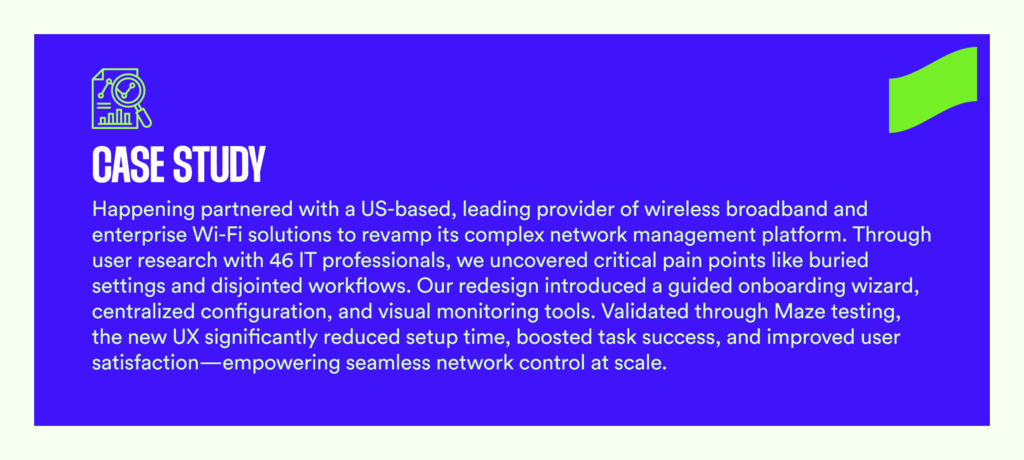

Rohan Sridhar
Posted On: June 23, 2025
Share
The telecommunications industry is at a pivotal moment. With the global rollout of 5G, the proliferation of IoT devices, and the integration of AI and cloud-native architectures, telecom networks are becoming faster, smarter, and exponentially more complex. In this dynamic landscape, user experience (UX) has emerged as a critical differentiator—not just for consumer-facing apps but for the intricate systems that power network operations, enterprise services, and customer interactions. At Happening Design, we specialize in crafting intuitive, scalable, and human-centered design solutions tailored to the telecom industry’s unique challenges. This blog explores our expertise, showcases our impact, and looks ahead to the future of UX in telecom.
The Telecom Boom: Statistics and Trends Shaping the Industry
The telecom sector is experiencing unprecedented growth and transformation. According to Statista, the global telecommunications market was valued at $1.66 trillion in 2023 and is projected to reach $2.1 trillion by 2030, driven by 5G adoption and IoT expansion. The International Telecommunication Union (ITU) reports that 5G networks covered 40% of the global population by the end of 2024, with over 2.7 billion 5G connections expected by 2026. Meanwhile, Gartner predicts that by 2025, 75% of enterprise data will be processed at the edge, fueled by IoT and AI-powered applications, placing immense pressure on telecom infrastructure.

The complexity of modern networks is staggering. A McKinsey report highlights that telecom operators are investing heavily in cloud-native architectures, with 60% of global operators adopting cloud-based BSS/OSS (Business Support Systems/Operational Support Systems) by 2025 to enhance agility and scalability. However, this transformation comes with challenges: Forrester notes that 68% of telecom IT leaders cite poor user experience in internal tools (e.g., network operations centers or NOCs) as a barrier to operational efficiency. These statistics underscore a critical truth: as telecom systems grow more sophisticated, intuitive design is no longer optional—it’s essential.
At Happening Design, we recognize that telecom UX extends beyond sleek consumer apps. It encompasses the dashboards used by NOC engineers, the provisioning tools for 5G orchestration, and the self-service portals for enterprise clients. Our mission is to bridge the gap between complex systems and human users, delivering designs that empower telecom providers to thrive in this era of connectivity.
Our Vertical Expertise: Telecom, Internet & 5G
Happening Design has built a reputation as a trusted partner for global telecom players and infrastructure providers, including industry leaders like Cambium Networks, Wipro, and B2B OEMs. Our portfolio spans a diverse range of projects, each addressing the unique demands of the telecom ecosystem:
- Network Management Systems: Streamlining workflows for NOC teams with real-time monitoring, fault detection, and intuitive visualizations.
- 5G Provisioning and Orchestration: Designing tools that simplify the deployment and management of 5G networks, from spectrum allocation to slice orchestration.
- Internet and ISP Dashboards: Creating user-friendly interfaces for ISPs to manage bandwidth, troubleshoot connectivity, and enhance customer support.
- Telecom SaaS Tools: Building scalable, cloud-native platforms that enable telecom providers to offer value-added services.
- White-Labeled Portals and Self-Service Platforms: Empowering enterprise clients and end-users with intuitive, branded interfaces for account management and service customization.
Our team’s domain fluency sets us apart. We speak the language of telecom, with deep expertise in network topologies, SNMP (Simple Network Management Protocol), mesh networks, device management, spectrum allocation, and BSS/OSS systems. This knowledge enables us to design solutions that are not only visually appealing but also technically aligned with the realities of telecom operations.

Design Challenges in Telecom (And How We Solve Them)
The telecom industry presents unique UX challenges that require a blend of technical expertise and creative problem-solving. Here are some of the most pressing challenges and how Happening Design addresses them:
- Complexity of Systems: Telecom networks involve intricate layers of hardware, software, and protocols. NOC dashboards, for example, must display real-time data on latency, packet loss, and spectrum usage while remaining intuitive. Our Solution: We employ data visualization best practices, such as hierarchical layouts and progressive disclosure, to present complex information in a digestible format. Our designs not only prioritize clarity, ensuring that engineers can make informed decisions quickly, but also minimize response time during outages or spikes and reduce troubleshooting time by 30%.
- Diverse User Groups: Telecom tools serve a wide range of stakeholders, from field technicians to C-suite executives. Each group has distinct needs and technical proficiency. Our Solution: We conduct thorough user research to map personas and workflows, creating tailored experiences that align with each user’s context. For instance, a technician’s mobile app might focus on troubleshooting guides, while a manager’s dashboard emphasizes KPIs and trends.
- Scalability and Futureproofing: With 5G and IoT driving exponential growth, telecom systems must scale seamlessly. Our Solution: We design modular, cloud-native interfaces that integrate with APIs and microservices, ensuring flexibility as networks evolve. Our work on 5G orchestration tools, for example, supports dynamic scaling and network slicing.
- Balancing CX and EX: Exceptional customer experience (CX) depends on seamless employee experience (EX). If internal tools are clunky, service quality suffers. Our Solution: We specialize in CX-to-EX mapping, aligning end-customer touchpoints with internal workflows. For instance, a self-service portal for customers is designed to sync with the OSS tools used by support teams, reducing friction across the service chain.
- Regulatory and Security Constraints: Telecom is a highly regulated industry, with strict compliance requirements for data privacy and network security. Our Solution: We incorporate security-by-design principles, ensuring that our interfaces support role-based access controls, audit trails, and GDPR/CCPA compliance.
Do you think it will be helpful to add an impact like - minimising response time during outages or spikes. In one case, this approach helped reduce troubleshooting time by 30%
Signature Capabilities That Set Us Apart
At Happening Design, our approach to telecom UX is defined by three core strengths:
- Domain Knowledge: Our team’s fluency in telecom concepts—such as SNMP, mesh networks, and BSS/OSS—enables us to hit the ground running. We understand the nuances of network topologies and spectrum management, allowing us to design solutions that resonate with both technical and business stakeholders.
- CX-to-EX Mapping: We go beyond surface-level design to create cohesive experiences that connect customers and employees. By aligning external touchpoints (e.g., self-service portals) with internal systems (e.g., CRM or OSS), we drive efficiency and satisfaction across the board. This approach is unique and will set us apart from other agencies because most of them only focus on CX. We focus equally on internal users—engineers, technicians, and NOC teams—mapping how operational experiences affect overall service quality.
- Co-Creation with Technical Teams: We don’t just design telecom—we collaborate with it. Our designers work hand-in-hand with engineering and product teams, leveraging our technical expertise to not only ensure that designs are feasible, scalable, and aligned with system architecture, but also reduce design-to-dev friction.
This is a great point. This approach is unique and will set us apart from other agencies because most of them only focus on CX. We focus equally on internal users—engineers, technicians, and NOC teams—mapping how operational experiences affect overall service quality.
May be we can add that it reduces design-to-dev friction to the list.
This point is a common claim by most design agencies, describing how deep that collaboration goes will set us apart.
Case Study

Happening partnered with a US-based, leading provider of wireless broadband and enterprise Wi-Fi solutions to revamp its complex network management platform. Through user research with 46 IT professionals, we uncovered critical pain points like buried settings and disjointed workflows. Our redesign introduced a guided onboarding wizard, centralized configuration, and visual monitoring tools. Validated through Maze testing, the new UX significantly reduced setup time, boosted task success, and improved user satisfaction—empowering seamless network control at scale.
Why Industry Depth Matters
In telecom, generic UX solutions fall short. Industry-specific expertise delivers tangible benefits:
- Faster Onboarding: Our familiarity with telecom systems means we require minimal ramp-up time, enabling quicker project timelines.
- Lower Rework: By understanding the technical and regulatory landscape, we avoid costly design iterations.
- Better Decision-Making: Our domain knowledge informs every design choice, from data visualization to workflow optimization.
- Meaningful Co-Creation: We partner with engineering and product teams as equals, fostering collaboration that drives innovation.
- True Partnership: At Happening Design, we’re not vendors—we’re invested in our clients’ success, with a “skin in the game” mentality that ensures accountability.

Looking Ahead: UX for the Next-Gen Network
The future of telecom is exhilarating. By 2030, 6G networks will begin to emerge, promising ultra-low latency and hyper-connectivity. IoT devices are projected to surpass 30 billion globally by 2027 (Ericsson Mobility Report), while AI will play a central role in predictive maintenance and network optimization. These advancements will demand UX that is not only intuitive but also adaptive to real-time data and diverse use cases.
Happening Design is already preparing for this future. We’re exploring AI-driven interfaces that anticipate user needs, such as predictive dashboards that flag issues before they arise. We’re also designing edge computing, ensuring that latency-sensitive applications remain user-friendly. And as telecom providers expand their SaaS offerings, we’re creating platforms that balance customization with scalability.
Conclusion
At Happening Design, we don’t just understand telecom—we speak its language. From the ground to the cloud, from devices to dashboards, we design with a deep awareness of systems, stakeholders, and the shifts shaping the networked world. Our expertise in network management, 5G orchestration, and customer-facing platforms empowers telecom providers to navigate complexity with confidence. As the industry races toward a hyper-connected future, we’re proud to be at the forefront, designing experiences that make connectivity seamless, intuitive, and impactful.
Ready to transform your telecom UX? Let’s connect and build the future together.
Get the best advice from our top talented subject experts. Any time. Any matter.

